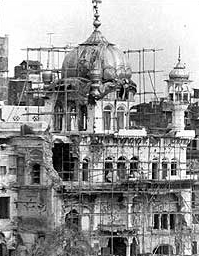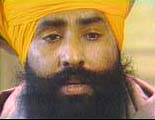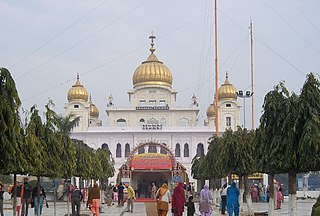
The Khalistan movement is a separatist movement seeking to create a homeland for Sikhs by establishing an ethno‐religious sovereign state called Khalistan in the Punjab region. The proposed boundaries of Khalistan vary between different groups; some suggest the entirety of the Sikh-majority Indian state of Punjab, while larger claims include Pakistani Punjab and other parts of North India such as Chandigarh, Haryana, and Himachal Pradesh. Shimla and Lahore have been proposed as the capital of Khalistan.

Operation Blue Star was a military operation by the Indian Armed Forces conducted between 1 and 10 June 1984 to remove Jarnail Singh Bhindranwale and other Sikh militants from the Golden Temple, a holy site of Sikhism, and its adjacent buildings.

Jarnail Singh Bhindranwale was an Indian militant. He was the leading figure of the Khalistan movement, although he did not personally advocate for a separate Sikh nation.

Babbar Khalsa also known as Babbar Khalsa International, is a Khalistani militant organisation that aims to create an independent nation-state of Khalistan in the Punjab region of South Asia. It has used armed attacks, assassinations and bombings in aid of that goal, and is deemed to be a terrorist entity by various governments. Besides India, it operates in North America and Europe, including Scandinavia.

Talwinder Singh Parmar was a Sikh militant and the mastermind of the 1985 Air India Flight 182 bombing, which killed 329 people. It was the worst single incident of aviation terrorism in history until the September 11 attacks in the United States. In addition, another bomb was meant to explode aboard Air India Flight 301 in Japan the same day, but it exploded while the plane was still grounded, killing two people. Parmar was also the founder, leader, and Jathedar of Babbar Khalsa International (BKI), better known as Babbar Khalsa, a Sikh militant group involved in the Khalistan movement.

The Insurgency in Punjab was an armed campaign by the separatists of the Khalistan movement from the mid-1980s to the mid-1990s. Economic and social pressures driven by the Green Revolution prompted calls for Sikh autonomy and separatism. This movement was initially peaceful, but foreign involvement and political pressures drove a heavy handed response from Indian authorities. The demand for a separate Sikh state gained momentum after the Indian Army's Operation Blue Star in 1984 aimed to flush out militants residing in the Golden Temple in Amritsar, a holy site for Sikhs. Terrorism, police brutality and corruption of the authorities greatly exacerbated a tense situation. By the mid-1980s, the movement had evolved into a militant secessionist crisis due to the perceived indifference of the Indian state in regards to mutual negotiations. Eventually, more effective police and military operations, combined with a policy of rapprochement by the Indian government and the election loss of separatist sympathizers in the 1992 Punjab Legislative Assembly election, largely quelled the rebellion by the mid-1990s.
Guru Nanak founded the Sikh religion in the Punjab region of the northern part of the Indian subcontinent in the 15th century and opposed many traditional practices like fasting, Upanayana, idolatry, caste system, ascetism, azan, economic materialism, and gender discrimination.
Sunder Singh Lyallpuri was a leading Sikh member of the Indian independence movement, a general of the Akali Movement, an educationist, and journalist. Lyallpuri played a key role in the development of the Shiromani Akali Dal, and in the Gurdwara Reform Movement of the early 1920s and also founding member of Central Sikh League. He took part in several roles in the establishment and growth of Indians independence.

Harchand Singh Longowal was the President of the Akali Dal political party during the Punjab insurgency of the 1980s. He had signed the Punjab accord, also known as the Rajiv-Longowal Accord with Rajiv Gandhi on 24 July 1985. The government accepted most of the Akali Dal demands, who in turn agreed to withdraw their activism. Less than a month after signing the accord, Longowal was assassinated.

Talhan is a village in Jalandhar district, near the Jalandhar Cantonment, in Punjab, India.
Babeli is a village in Tehsil Phagwara, Kapurthala district, in Punjab, India.

Gurdwara Fatehgarh Sahib is a Sikh gurdwara or place of worship in the city of Fatehgarh Sahib in the Indian state of Punjab. The gurdwara marks the 1710 conquest of the city by the Sikhs under the leadership of Banda Singh Bahadur. Sikhs captured the area and razed the fort built by Ferozshah Tughlaq to the ground.

A Jatha is an armed body of Sikhs that has existed in Sikh tradition since 1699, the beginning of the Khalsa. A Jatha basically means a group of people.

Akali Phula Singh Nihang was an Akali Nihang Sikh leader. He was a saint soldier of the Khalsa Shaheedan Misl and head of the Budha Dal in the early 19th century. He was also a senior general in the Sikh Khalsa Army and commander of the irregular Nihang of the army. He played a role in uniting Sikh misls in Amritsar. He was not afraid of the British who at many times ordered for his arrest but were not successful. During his later years he served for the Sikh Empire as a direct adviser to Maharaja Ranjit Singh. He remained an army general in many famous Sikh battles up until his martyrdom in the battle of Nowshera. He was admired by the local people and had a great influence over the land and his settlement was always open to help the poor and helpless. He was well known and was a humble unique leader and prestigious warrior with high character. He was also known for his effort to maintain the values of Gurmat and the Khalsa panth.

The Babbar Akali movement was a 1921 splinter group of "militant" Sikhs who broke away from the mainstream Akali movement over the latter's insistence on non-violence over the matter of the restoration of Khalsa Raj in Punjab as under the prior Sikh Empire as well as gurdwara reforms in restoring pre-colonial gurdwara environments.

The Akali movement, also called the Gurdwara Reform Movement, was a campaign to bring reform in the gurdwaras in India during the early 1920s. The movement led to the introduction of the Sikh Gurdwara Bill in 1925, which placed all the historical Sikh shrines in India under the control of Shiromani Gurdwara Parbandhak Committee (SGPC).

Baba Hanuman Singh, also known as Akali Hanuman Singh or Amar Shaheed Baba Hanuman Singh, was a Nihang Sikh and was the 7th Jathedar of Budha Dal and Jathedar of Akal Takhat. He was the successor of Akali Phula Singh. He was the first one who fought against the British. He attained martyrdom during a battle with the British and Patiala Stac in 1846.

The 1978 Sikh–Nirankari clash occurred between the Sant Nirankari Mission and Sikhs of Damdami Taksal and Akhand Kirtani Jatha on 13 April 1978 at Amritsar, Punjab, India. Sixteen people—thirteen traditional Sikhs and three Nirankari followers—were killed in the ensuing violence, occurring when some Akhand Kirtani Jatha and Damdami Taksal members led by Fauja Singh protested against and tried to stop a convention of Sant Nirankari Mission followers. This incident is considered to be a starting point in the events leading to Operation Blue Star and the 1980s Insurgency in Punjab.

Kishan Singh Gargaj (1886-1926) was an Indian revolutionary from Punjab and was one of the founders of the Babbar Akali movement. Known mainly for his martyrdom for the cause of the movement, he was one of the renowned martyrs in the Babbar Akali movement.

Dhanna Singh was a Sikh revolutionary and part of the Babbar Akali movement for India's freedom from British rule. He died on October 26, 1923, while resisting arrest during his own suicide bombing; the bomb killed seven officers.
















